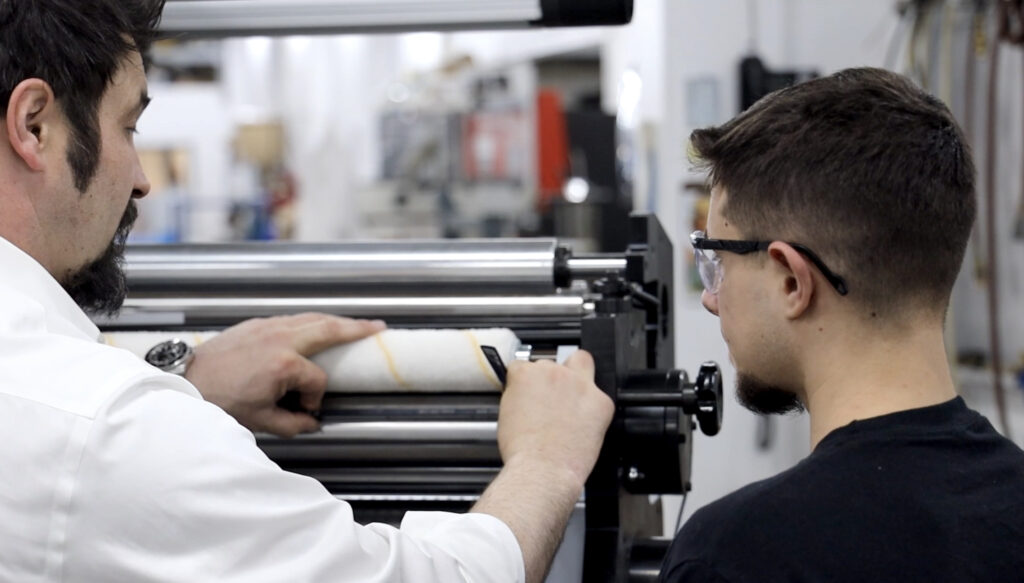Converters and web processing lines handle many different types of substrates that require a wide range of tension while processing at very high speeds. Web finishing equipment must convey a web of various materials without defects such as wrinkles. Rollers are necessary to hold the right amount of tension during the conveying process.
There are a variety of roll types, such as pull rolls, idler rolls, edge guides, and spreaders, that control the web and keep it on track.
How are Pull Rolls Used in a Web Conveying System?
Pull rolls are a series of rollers that assist materials in conveying through the web processing line. The type of pull rolls can take on various forms with the selection depending on the web finishing requirements. Pull rolls are found in every web processing line and perform many functions such as:
- Controlling the web tension as materials move through each section
- Conveying the web at a particular speed
- Altering the web tension when needed between sections
- Feeding or removing the web from a specific process point
- Isolating one web section from another
The pull rolls must be driven with torque transmitted to produce minimum slippage between the web and the roll surface. Providing good web tension isolation between the various processes, the winding tension, and the unwind is the paramount rule in proper web handling. The pull rolls require sufficient grip on the web to provide the tension required.
Types of Pull Rolls
There are different types of pull Rolls used in web finishing machinery and equipment with various design features, advantages, and disadvantages. The most common types of pull rolls include:
- S-Wrapped pull rolls
- Omega-wrapped pull rolls
- Nip pull rolls
- Vacuum pull rolls
S-WRAPPED PULL ROLLS
S-wrapped pull rolls consist of two driven rolls, typically rubber covered, with the web passing through them in an “S” configuration.
S-Wrapped Pros: creates increased force with two rolls, both contacting the web at a rapid angle that greatly increases force and tension.
S-Wrapped Cons: both sides of the web contact S-wrap pull rolls, which may not be ideal in all web finishing applications. Because two rolls are used, S-wrap pull rolls typically cost more than Omega pull rolls.
OMEGA-WRAPPED PULL ROLLS
The Omega-wrapped pull roll is the most basic design featuring two idler rolls that guide the web around one driven Omega-shaped pull roll. Tension is required within the web prior to and after moving through the pull roll to ensure torque is free from friction.
Omega wrapped Pros: the basic design is the least expensive type of pull roll, and the web only contacts one side of the roller.
Omega wrapped Cons: limited force can be applied due to the amount of rapid angle on a single driven roll.
NIP PULL ROLLS
Nip pull rolls provide the ability to enhance applied force as the web is guided between a driven roll and a pressure roll, pressed against the pull roll. Typically one of the two features a softer surface such as rubber to avoid damaging the surface of the rolls when pressed together.
Nip Roll Pros: high tension differences are achievable before and after nip rolls without causing damage to various materials from the pressure. Nip rolls enhance frictional force between the roll in the web at high speeds where any entrapped air can be ironed out to prevent a reduction of frictional force.
Nip Roll Cons: nip roll pull systems are more costly than other types of pull rolls and cannot be used on all types of webs.
VACUUM PULL ROLLS
Vacuum pull rolls, or suction rolls, contain many small holes on the surface to provide suction when transporting the web.
Vacuum Pull Roll Pros: friction is greatly enhanced due to the vacuum/suction design. Provide effective friction, particularly in areas where the wrap angle is limited and touches only one side of the web.
Vacuum Pull Roll Cons: vacuum pull roll systems are more expensive to purchase and operate, they can be noisy, and require increased maintenance over other types of pull roll systems
Speak with an experienced web finishing equipment manufacturer such as Tamarack® Products, a world-leading supplier of specialized equipment used in the form, label, and packaging industry.
Tamarack® Products offers more than 50 years of experience as a leading global supplier of high-quality web finishing equipment, including inline film/window patching and RFID inlay insertion systems. Contact us with any questions on selecting the right type of pull rolls for your web finishing conveying process.





